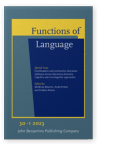The linguistic realization of continuative discourse relations in English discourse
A context-based analysis across narrative and argumentative genres
This paper examines the linguistic realization of continuative discourse relations in British English written
discourse comparing narrative and argumentative dyadically edited texts. The data comprise 18 co-edited texts and metadata
documenting the editing process (keystroke logs and transcripts of the dyads negotiating discursive well-formedness). The focus of
analysis lies on the linguistic realization of coordinating continuation and narration, which keep the discourse
on the same level, and on the linguistic realization of subordinating elaboration and explanation, which
introduce a deeper level in the discourse hierarchy. Special attention is paid to contexts in which the discourse relations are
encoded in intra-clausal coherence strands, and to contexts in which they are additionally signalled in the peripheries. The
quantitative analysis of the signalling of continuative discourse relations shows genre-specific preferences for the signalling of
continuation and elaboration in the argumentative data, and continuation, narration and
explanation in the narrative data. Both the products of the edited data, the co-edited texts, and the metadata show
that the linguistic realization and interpretation of continuative discourse relations are – to varying degrees – subject to
recontextualization. We suggest that this variation provides evidence for (1) discourse relations as constitutive parts of
discourse grammar, and (2) genre as a blueprint which constrains their linguistic realization.
Article outline
- 1.Introduction
- 2.Continuative discourse relations
- 3.Method and data
- 4.Results
- 4.1Quantitative analysis
- 4.2Qualitative analysis
- 4.2.1Argumentative data
- 4.2.2Narrative data
- 5.Discussion
- 6.Conclusion
- Acknowledgements
- Notes
-
References
